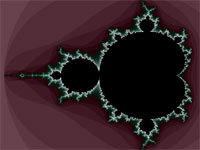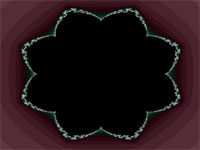
|
||
| Release 4.0 | ||
 |
Escapetime - Transformation Formulas
A transformation formula transforms the simple rectangular shape (the default shape coming from the direct mapping of the window to a part of the complex number plane) into another shape. This formula is rather simple to write and understand, because all it does - or better - has to do, is to modify the value of the predefined variable pixel.
A transformation formula can have upto three member function:
- void init_once(void): Called only once, i.e. when the fractal calculation starts: In this routine you can initialize variables and allocate arrays.
- void transform(void): This is the main member function: Its purpose is to modify the value of pixel.
- void description(void): This member function lets you define labels for your parameters, enumeration lists, default values and hints. Each formula can have a description function.
So a transformation mainly consists of a member function void transform(void) which gets called for each pixel before the main fractal loop gets called.
Thus a transformation could look as follows:
rotOrder
{
real dAngle;
real dist;
void init_once(void)
{
// nothing to do...
}
void transform(void)
{
dAngle= arg(pixel);
if (dAngle< 0) {
dAngle=dAngle+2*pi;
}
dist= |pixel|;
dAngle= dAngle-floor(dAngle*4/pi)*pi/4;
if (dAngle> pi/8) {
dAngle=pi/4-dAngle;
}
pixel= (cos(dAngle)*dist+(0,1)*(sin(dAngle)*dist));
}
void description(void)
{
this.title = "Rotation Symmetry";
}
}
Have a look at these images: They show you the effect of that transformation. The transformation
applies rotation symmetry to the fractal, so that the area from -22.5 degrees to +22.5 degrees
gets repeated 8 times.
 Standard fractal |
 With transformation from above. |
So all you need to do is to modify the predefined variable pixel!










